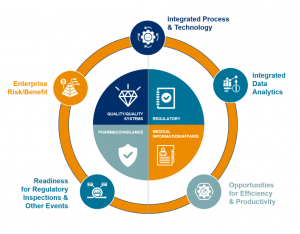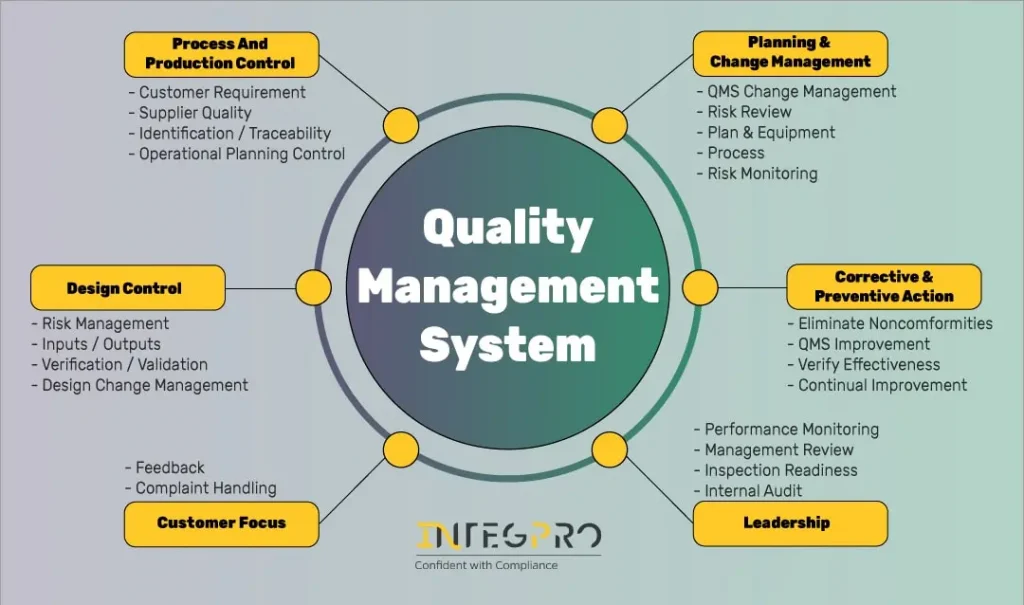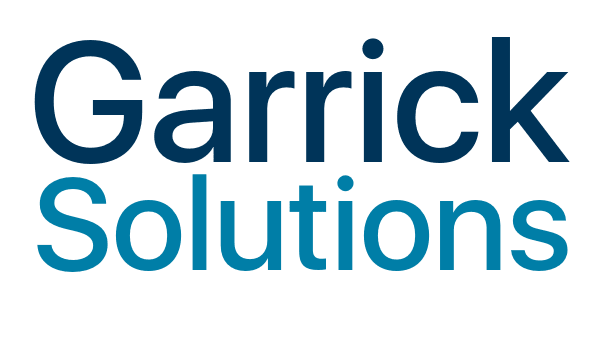
In today’s fast-paced business world, efficiency and compliance are two key factors that can make or break a company’s success. That’s why integrating quality management and compliance systems has become increasingly important. By combining these two essential components, organizations can ensure process efficiency and regulatory compliance, ultimately leading to improved productivity, customer satisfaction, and long-term success. In this article, we will explore the benefits of integrating quality management and compliance systems and how they work together to drive organizational excellence.
When it comes to quality management, the focus is on consistently meeting or exceeding customer expectations. By implementing robust quality management systems, companies can streamline their processes, identify and address any issues or bottlenecks, and continuously improve their products or services. On the other hand, compliance systems ensure that organizations adhere to industry regulations, standards, and legal requirements. By integrating these systems, companies can create a seamless and cohesive approach to managing quality and compliance, eliminating duplication of efforts and maximizing efficiency.
By integrating quality management and compliance systems, companies can enjoy a multitude of benefits. Firstly, it allows for better risk management by identifying potential risks and implementing preventive measures. This proactive approach not only minimizes the chances of non-compliance but also reduces the likelihood of quality-related issues and customer dissatisfaction. Secondly, it fosters a culture of continuous improvement by providing valuable data and insights into areas that need attention or enhancement. This data-driven approach enables organizations to make informed decisions and take corrective actions promptly, ensuring that processes are optimized and customer satisfaction is maximized.
In conclusion, integrating quality management and compliance systems is a strategic move that can bring significant benefits to organizations. By ensuring process efficiency and regulatory compliance, companies can enhance their reputation, build customer trust, and achieve sustainable success. So, if you’re looking to take your business to the next level, it’s time to consider integrating these systems and reaping the rewards.
Integrating quality management and compliance systems offers numerous benefits for organizations. By ensuring process efficiency, businesses can streamline their operations, reduce errors, and improve productivity. Combining these systems also helps companies meet regulatory compliance requirements, mitigating the risk of penalties and legal issues. With integrated quality management and compliance systems, organizations can establish standardized processes and monitor performance effectively. This integration enhances transparency, accountability, and overall organizational effectiveness. By prioritizing quality management and compliance, businesses can drive continuous improvement and maintain a competitive edge in their respective industries.

The Benefits of Integrating Quality Management and Compliance Systems to Ensure Process Efficiency and Regulatory Compliance
In today’s highly regulated business environment, organizations are constantly striving to improve their processes and ensure compliance with various industry standards and regulations. One effective way to achieve this is by integrating quality management and compliance systems. By combining these two essential elements, businesses can streamline their operations, enhance efficiency, and maintain adherence to regulatory requirements. In this article, we will explore the numerous benefits of integrating quality management and compliance systems and how they contribute to process efficiency and regulatory compliance.
Enhanced Process Efficiency
Integrating quality management and compliance systems leads to enhanced process efficiency by eliminating redundant tasks and optimizing workflow. These integrated systems provide a centralized platform where organizations can monitor and manage their quality processes and compliance requirements. By automating manual processes and streamlining data collection, businesses can reduce errors, minimize delays, and improve overall productivity.
Furthermore, the integration of quality management and compliance systems allows for real-time monitoring of key performance indicators (KPIs) and metrics. With access to accurate and up-to-date data, organizations can identify bottlenecks, identify areas for improvement, and make data-driven decisions to enhance process efficiency. This proactive approach enables businesses to optimize their operations, allocate resources effectively, and achieve higher levels of productivity.
Ensured Regulatory Compliance
Compliance with industry regulations and standards is crucial for organizations across various sectors. Failure to comply with these requirements can result in severe consequences, including legal penalties, reputational damage, and loss of customer trust. By integrating quality management and compliance systems, businesses can ensure regulatory compliance by establishing standardized processes and controls.
Integrated systems provide a structured framework for documenting, implementing, and monitoring compliance measures. Organizations can define compliance workflows, automate documentation processes, and schedule regular audits to ensure ongoing adherence to regulatory requirements. By centralizing compliance activities, businesses can easily track and manage compliance-related tasks, reducing the risk of non-compliance and associated penalties.
Benefits of Integrating Quality Management and Compliance Systems
1. Streamlined Processes: Integration eliminates duplicate efforts and promotes consistency, resulting in streamlined processes and improved efficiency.
2. Improved Data Accuracy: By automating data collection and reducing manual entry, integrated systems enhance data accuracy and reliability.
3. Enhanced Visibility: Integrated systems provide real-time visibility into quality and compliance metrics, enabling proactive decision-making.
4. Cost Savings: By eliminating manual processes and reducing errors, businesses can achieve cost savings in terms of time, resources, and potential fines.
5. Regulatory Confidence: Integrating quality management and compliance systems instills confidence in regulators and stakeholders, demonstrating a commitment to compliance and quality.

Best Practices for Integrating Quality Management and Compliance Systems
1. Clearly Define Objectives: Before integration, organizations should clearly define their objectives and desired outcomes to ensure alignment with their overall business goals.
2. Select the Right Software: Choose a quality management and compliance system that meets the specific needs of your organization, considering factors such as scalability, user-friendliness, and integration capabilities.
3. Involve Stakeholders: Involve key stakeholders from various departments to ensure their buy-in and collaboration throughout the integration process.
4. Provide Training and Support: Offer comprehensive training and ongoing support to employees to ensure a smooth transition and maximize the benefits of the integrated system.
5. Regularly Monitor and Evaluate: Continuously monitor and evaluate the performance of the integrated system to identify areas for improvement and make necessary adjustments.
Conclusion
Integrating quality management and compliance systems offers numerous benefits for organizations seeking to enhance process efficiency and ensure regulatory compliance. By streamlining processes, improving data accuracy, and providing real-time visibility, businesses can optimize their operations and maintain adherence to industry standards. With the right approach and commitment to best practices, organizations can leverage the power of integrated systems to drive efficiency, reduce costs, and achieve regulatory confidence.
The Benefits of Integrating Quality Management and Compliance Systems to Ensure Process Efficiency and Regulatory Compliance
- Improved process efficiency by streamlining quality management and compliance procedures.
- Reduced risk of non-compliance with regulatory requirements through integrated systems.
- Enhanced data accuracy and reliability by centralizing information in a single system.
- Increased transparency and visibility into quality and compliance metrics for better decision-making.
- Cost savings by eliminating duplication of efforts and minimizing the need for manual processes.
Frequently Asked Questions
1. How does integrating quality management and compliance systems benefit a company?
Integrating quality management and compliance systems offers numerous benefits for a company. Firstly, it enhances process efficiency by streamlining operations and reducing errors. By implementing standardized procedures and guidelines, companies can ensure that their processes are carried out consistently and efficiently. This leads to improved productivity and cost savings as resources are utilized more effectively.
Secondly, integrating these systems helps companies achieve regulatory compliance. Compliance with industry regulations and standards is crucial to avoid legal penalties and maintain the company’s reputation. By integrating quality management and compliance systems, companies can automate compliance monitoring and reporting, ensuring that they meet all the necessary requirements. This not only saves time and effort but also provides peace of mind that the company is operating within the boundaries of the law.
2. How can integrating quality management and compliance systems improve product quality?
Integrating quality management and compliance systems plays a significant role in improving product quality. By implementing robust quality control measures and standards, companies can identify and address any issues or defects at an early stage. This helps prevent the production of faulty or substandard products, reducing customer complaints and returns.
Furthermore, integrating these systems allows for better traceability and documentation of the entire product lifecycle. This means that companies can track and monitor every step of the production process, ensuring that quality standards are consistently met. By having a comprehensive view of the product’s journey, companies can identify areas for improvement and make data-driven decisions to enhance product quality.
3. What impact does integrating quality management and compliance systems have on customer satisfaction?
Integrating quality management and compliance systems has a positive impact on customer satisfaction. By implementing rigorous quality control measures, companies can ensure that their products and services consistently meet or exceed customer expectations. This leads to increased customer satisfaction and loyalty.
In addition, integrating compliance systems helps companies maintain transparency and accountability in their operations. Customers value companies that prioritize ethical practices and comply with industry regulations. By demonstrating a commitment to regulatory compliance, companies build trust and credibility with their customers, further enhancing satisfaction levels.

4. How does integrating quality management and compliance systems contribute to risk mitigation?
Integrating quality management and compliance systems is crucial for effective risk mitigation. By implementing standardized processes and controls, companies can identify potential risks and take proactive measures to mitigate them. This includes identifying and addressing compliance gaps, ensuring that the company operates within legal boundaries.
Moreover, integrating these systems allows for better documentation and tracking of incidents and non-conformities. This enables companies to analyze trends and patterns, identify root causes, and implement corrective actions to prevent similar risks in the future. By having a comprehensive risk management framework in place, companies can minimize the likelihood of financial, legal, and reputational risks.
5. How can integrating quality management and compliance systems optimize resource utilization?
Integrating quality management and compliance systems optimizes resource utilization by eliminating inefficiencies and reducing waste. By streamlining processes and implementing standardized procedures, companies can minimize unnecessary steps and reduce the time and resources required to complete tasks.
Additionally, these systems enable better tracking and monitoring of resource usage. By having clear visibility into resource allocation and consumption, companies can identify areas of improvement and make informed decisions to optimize resource utilization. This includes identifying bottlenecks, reallocating resources, and implementing measures to reduce waste and maximize efficiency.

Final Summary: The Power of Integration for Process Efficiency and Regulatory Compliance
Bringing together quality management and compliance systems can prove to be a game-changer for businesses looking to streamline their processes and ensure regulatory compliance. By intertwining these two aspects, organizations can reap a multitude of benefits that enhance their overall efficiency and adherence to industry regulations. With a focus on search engine optimization and an engaging writing style, let’s explore the advantages of integrating quality management and compliance systems.
Integrating quality management and compliance systems offers businesses the opportunity to achieve enhanced process efficiency. By consolidating these two critical aspects, organizations can establish standardized procedures and workflows, eliminating redundancies and improving overall productivity. Streamlining processes not only saves valuable time and resources but also allows businesses to deliver products and services more efficiently, leading to increased customer satisfaction and loyalty.
Moreover, this integration plays a vital role in ensuring regulatory compliance. By aligning quality management practices with compliance requirements, businesses can proactively address potential risks and avoid costly penalties. The integration of these systems enables organizations to stay up-to-date with changing regulations, implement necessary controls, and consistently monitor their operations for compliance. This not only safeguards the company’s reputation but also builds trust with stakeholders, including customers, partners, and regulatory bodies.
In conclusion, integrating quality management and compliance systems is a strategic move that can revolutionize how organizations operate. From bolstering process efficiency to guaranteeing regulatory compliance, this integration provides a solid foundation for sustained success and growth. By embracing this approach, businesses can navigate the complex landscape of quality and compliance with ease, while reaping the benefits of streamlined operations, improved customer satisfaction, and a strong market position. So, take the leap and harness the power of integration in driving your business towards excellence.


